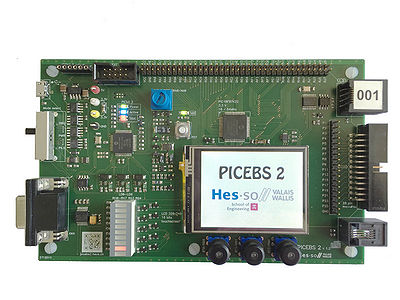Hardware/PICEBS/Welcome
| Line 8: | Line 8: | ||
PICEBS2 ([[Hardware/PICEBS/2|hardware details]]) is the name of a small embedded computer board targeted at teaching embedded systems programming. | PICEBS2 ([[Hardware/PICEBS/2|hardware details]]) is the name of a small embedded computer board targeted at teaching embedded systems programming. | ||
| − | As its name suggests, it is the second iteration of a successful family of Microchip PIC board, this time with the objective to realize an all-in-one system (the debugger | + | As its name suggests, it is the second iteration of a successful family of Microchip PIC board, this time with the objective to realize an all-in-one system (the debugger PICKIT3 is included on board). |
| − | + | Please note that, as a student, you can loan a board during your HES-SO//Valais studies to work at home ;-) Just ask the laboratory responsible [[User:sap|Pascal Sartoretti]] (sap). | |
[[File:PICEBS2.jpg|400px|center]] | [[File:PICEBS2.jpg|400px|center]] | ||
Revision as of 13:04, 18 August 2015
|
Welcome to the PICEBS2 wiki
If you don't know what the PICEBS2 project is, have a look a the presentation.
Presentation
PICEBS2 (hardware details) is the name of a small embedded computer board targeted at teaching embedded systems programming. As its name suggests, it is the second iteration of a successful family of Microchip PIC board, this time with the objective to realize an all-in-one system (the debugger PICKIT3 is included on board).
Please note that, as a student, you can loan a board during your HES-SO//Valais studies to work at home ;-) Just ask the laboratory responsible Pascal Sartoretti (sap).
We, the PICEBS2 team, provide a comprehensive solution for
- Practical work for HEI courses Information systems
- All kind of project featuring a low-sized micro-controller.
What can be done with the PICEBS2 ?
The board is powerful enough to run applications with:
- LCD and touch screen interface
- Serial port usage (UART)
- CAN interface
- ...
- This board includes the PICKIT3 for programming and debugging
Hardware
Here is a list of the main PICEBS2's characteristics:
- CPU PIC18F87K22
- High range PIC18 family with 128kB Flash & 4kB RAM
- RTC
- 12 bits ADC
- 11 timers
- UART, SPI, I2C
- ...
- Onboard PICKIT3 debugger
- Compatible with MPLABX
- Can be used standalone or turned off
- LCD Display
- 320x240, 265k colors
- Backlight
- Resistive touch screen
- Networking and communication
- CAN bus
- RS232
- PS2 keyboard
- Olimex UEXT
- Development
- All CPU pins are available on a connector
- Standard Hes-so//Valais 26 pin header on board
Software
- Source files for assembler laboratories
- Source files for C laboratories
- Tools
Tips & tricks
- CPU speed control
// to work with maximum CPU speed (64MHz) insert following code at start. PLLEN = 1; // activate PLL x4 OSCCON = 0b01110000; // for 64MHz cpu clock (default is 8MHz) ...
- Change one bit on a port
// to change one bit on a port, use LATx and not PORTx LATH2 = 1; // turn led on for example ...
- Interrupt on change on PORTB (RB4-RB7)
// to clear the interrupt flag you have to read the PORTB ... PORTB; // clear the latch change on PORTB RBIF = 0; // clear the interrupt itself ...
- Reduce current consumption
// To reduce consumption at minimum, do at least LCD_PowerOff(); // turn all LCD parts off UART_PowerOff(); // turn UART driver off Can_PowerOff(); // turn off MCP2515 chipset // And define unused GPIOs as output TRISB5 = 0; // for example ... // You can measure (between white and yellow test points) about 630 uA after a SLEEP();
Bugs, issues, questions and comments
Feel free to contact the PICEBS2 team when you encounter a problem. Don't forget to have a look at the Tips & tricks section.
